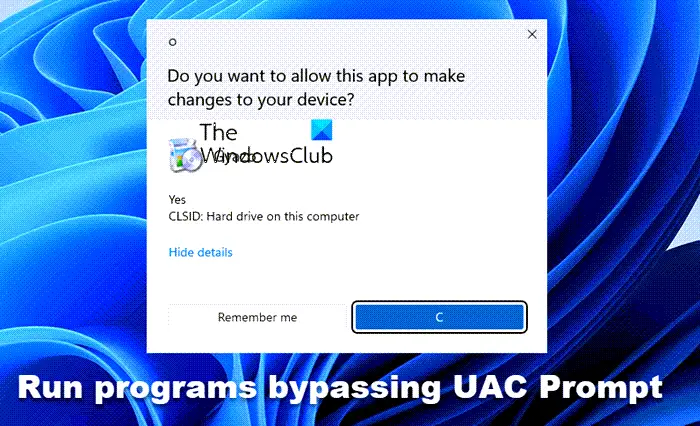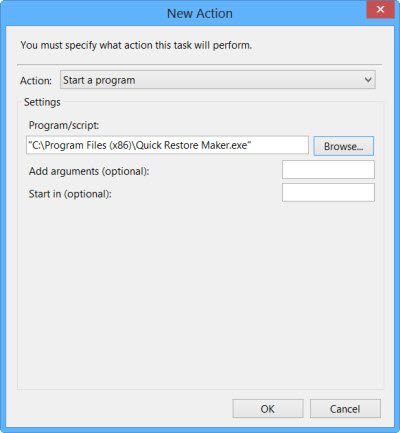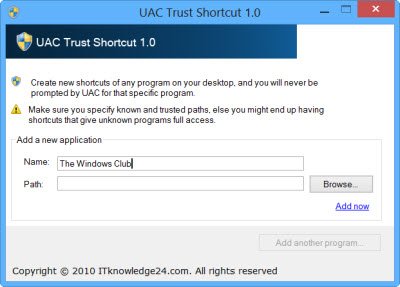The User Account Control or UAC basically notifies you before changes are made to your PC – not all changes, but only those which require Administrator level permissions. Whenever you run some programs, you will get to see the UAC Prompt first. Only after you give your consent, will the program run. This is a security feature that is best left at this default behavior. But you may have some programs that you run very frequently and which you trust completely. In such cases then the UAC Prompt could become an irritant.

While you should never disable the UAC prompts for the whole computer, you may want to bypass the UAC Prompt and disable it for certain applications, using the Microsoft Application Compatibility Toolkit. You can read more about this at Changing User Account Control settings.
Run programs bypassing UAC Prompt
If you wish to disable the UAC prompt for specific programs, you can also create an elevated shortcut for the program, that will allow you to bypass UAC Prompt and run the program without seeing the UAC Prompt in Windows. This is how you can do it.
- Type Schedule Tasks in Start Search and hit Enter to open the Task Scheduler.
- Under Actions, click on Create Task.
- Follow this post on how to create a task in Task Scheduler.
- Under General tab, give the Task a name, say NoUAC1.
- Check Run with highest privileges.
Follow these steps after completing the above steps.

Under the Action tab, click on the New button and browse to the folder location of the program executable file and select it. The Action should be Start a program.
Under the Settings tab, ensure that Allow task to be run on demand is checked.
Once all this is done, click on OK. A new Task will be created and you will be able to see it.
Create Elevated Program Shortcut
Now you will have to create a shortcut that will run this task.
Right-click on the desktop > New > Shortcut. In the Create Shortcut wizard, type:
schtasks /run /TN "NoUAC1"
Here NoUAC1 should be replaced with the name for the task that you have chosen. Click on Next and exit the wizard after it runs its course.
Now you can give it an icon of your choice. To do so, right-click on the shortcut > Properties > Change icon. Browse and select the icon you want.
Now when you click this shortcut, you will be able to bypass the UAC Prompt.
If this is too much work, you can use this free tool to create an elevated program shortcut to run a specified program bypassing the UAC Prompt.
UAC Trust Shortcut is a freeware that lets you quickly create an elevated shortcut to run programs bypassing the UAC Prompt. It is available for 32-bit and 64-bit Windows.

You can download UAC Trust Shortcut here. It requires to be installed.
Have a nice day!


Thanks so much.
Your reminder couldn’t come at a better time! Yesterday, I installed an NLE from a very reputable vendor (they were even at IBC’s RAI in Amsterdam last week); its installer at finish causes prompt “windows must be restarted to disable User Account Control”. In my case, I’ve got so much layered security UAC has almost become redundant anyway (zillions of stops/warnings if UAC off), but that’s not the case for a good many users! Though my NLE isn’t likely to turn malevolent, what about OTHER programs that might not play so nice? Your advice is thus great for me, and for anyone put off by great apps which have for them a creepy UAC requirement; don’t know why some devs still “need” to deactivate UAC for their apps to work, but in those rare instances where an app CAN be trusted your words on keeping UAC on with app-by-app permissions could help many users. Thanks again!
This is why Windows SUCKS. This is EXACTLY WHY.
Do I need to have the admin account for this? Cause I can’t make a task. The Task Scheduler says it needs user account info, asking for a password. Im using a standard user account so it has no pw. And I cant use one of the freewares, each needs an admin pass.
Came in here looking for just the converse of this. Sir, how do I make applications/folders prompt for UAC before opening them. So it would serve as a folder/application lock without having the need to use 3rd party applications.
As I understand it, you want to make applications always prompt for UAC before opening them, right?
The User Account Control basically notifies you before (Administrator level) changes are made to your PC.
If opening a software does not make changes, the UAC will not come into picture. The same is the case when you open a folder.
I therefore do not think this may be possible.
Arrrgghhhhh! Don’t publish technical advice with non-standard quotation marks in example command lines!!!
Attention READERS:
Don’t copy and paste the Task Scheduler command line that the author provided! If you do, you’ll spend thirty minutes, as I just did, trying to figure out why your application launches directly from Task Scheduler, but fails to launch from a Task Scheduler command line or shortcut. It’s because those aren’t the required standard quotes that he shows in his command line.
Sloppy.
Thanx V.R. Enigma u saved my precious 30 Minutes…..
You’re very welcome, Kashish. Nice to hear. :-)
Frankly, I see this as a ridiculous remark. UAC is a safety feature. Our machines are no longer CPU islands; they’re connected to the world.
As an administrator, you give ever piece of malware every privilege to your computer that you have – which is to say, all of them.
Security, safety, sensible.
Agreed, Anand. UAC is a graduated limitation; it’s not a gate welded shut.
Create a separate user account and give that user the applications you want him to have.
Or you might like to try Windows Live Parental Control; downloadable, free, Msft. That might do it.
Failing that: third-party apps.
That’s just a silly comment.
OSX not only requires your permission to run something that could affect the system, it requires you to enter your password. Linux not only requires your permission to run something that could affect the system, it requires you to enter your password. Windows requires your permission to run something that could affect the system, DOESN’T require entering your password which is even less intrusive than other Operating Systems, and WINDOWS is the one that “SUCKS?”
It’s fine if you prefer another OS over Windows, which you obviously do (Linux?), but make sure when you try and slam another OS, you pick something that is actually relevant rather than stretching so hard you look like Gumby.
How do I force it to execute minimized?
requires admin to run
apparently you are NOT a software cracker or you would know to remove the quotation marks lol
Quotation marks are required, Nick. But, on the command line, they must be standard quotation marks, not typographic quotation marks. The two types are sometimes almost visually indistinguishable. To his credit, it appears that the author has replaced the original typographic quotes with standard quotes. I trust that clears up your confusion.
Ive only EVER seen people use the quotations used here. I looked up “typographic” and it seems to only mean they are not curved. Dont think Ive ever seen curved quotation marks on a keyboard depending on the application (think word does it).
When reading a tutorial or cracking software you almost always know “yourfile” means those quotations are placeholders to tell you to insert your chosen file name.
Also if you see the “lol” at the end youll realize that was a sarcastic “its happened to us all at one time” laugh
Again, Nick, the author included quotation marks because they are required, since the fully-specified application name may very likely contain spaces. To better understand, give this a try:
Follow the author’s instructions by copying this command line
schtasks /run /TN “NoUAC1”
Leave those existing quotations in place and just paste or type in your path, replacing the NoUAC1 placeholder. Test to see if it works. Doesn’t work, does it?
Next, do the exact same thing again, but use this command line
schtasks /run /TN “NoUAC1”
You’ll see that the second command line works. But, why? At first glance, the two command lines look identical. But they aren’t. The first one, which is what the author had in the article when it was originally posted, contains typographic quotation marks.
Automatic straight quote-to-typographic quote conversion has been in word processing applications for a couple of decades now. Consequently, if you use a word processor to write a technical article which contains lines of code, and then paste that article into a blog, you’ll wind up with typographic quotes where you should have straight quotes.
Hope this helps you avoid a similar headache somewhere down the road.
I agree with him… This does suck… If the feature was useful, it would have the ability to right click on file to turn it on or off… Not have to go through stupid steps that don’t work or install third party apps to do what you want…
Installing additional third party apps to make the OS more useable is more of a security risk
This worked fine until I rebooted. However, I created another shortcut to the task and it worked the second time?
This is the approach I used under Win 7. However, I’m just moving over to Win 10, and I can’t get it to work unless I run the short cut as administrator – which triggers the UAC prompt and rather defeats the objective. Any ideas?
What a nonsense, UAC is system level security, doing what you suggest would open the door to malware deactivating UAC for itself. At least Windows does not force you to enter your password, thing that competitors OS do.
Very hard to get a UAC bypasser when when you try to install it the UAC kicks in
(Necro, I know… sue me)
The difference is that on Linux and MacOS, I can set up sudo (which is the tool used to run a program with elevated privileges by authenticating a user) in such a way that it will allow certain programs to be started by the user without them having to supply a password. This can be done in an easy and clean manner, the functionality was build right into the software that handles this kind of thing.
On Windows you can’t do this in any other way than some hackery through the task scheduler, which clearly wasn’t meant to be used like this. I have this issue on a production system at my company but I won’t use this solution in a production environment.
hi
For Windows 7, the shortcut creation needs more details:
Close Task Scheduler. Right-click an empty spot on your Desktop and select
New > Shortcut. In the Create Shortcut window enter the following text:
C:WindowsSystem32schtasks.exe /run /tn “WPDTaskName”
(WPD is probably the location of your task as shown in Task Scheduler console under Task Scheduler Library).
Install a shim with the signature of the app and the compatibility settings you want to grant it, such as running as Administrator. I think that will do what you want.
It’s purposely difficult because it’s not supposed to be easy to bypass security or else malware writers and hackers would take advantage of it.
See my comment above about installing compatibility shims.
Why would you create your task under the WPD folder? Most people create their custom tasks at the root. I’m sure that was assumed in the article.
Note that by default, only the Creator and Administrators can access and start the Scheduled Task by default.
I’m not sure if it’s safe to share this, but if your Scheduled Task is configured to run as Local System (or some other privileged account) and you want a non-Administrator to be able to initiate it from the above-described Program Shortcut, you can make this possible by granting Everyone Full Control to the task file located at C:WindowsSystem32Tasks(task_file_name).
I used this method to provide a desktop shortcut to end users to enable them to initiate a Windows 10 Upgrade (pre-cached on the machine) without Administrator privilege. It’s a nifty trick. However, users will not be able to see or interact with the running task because it’ll be running in the System session.
Try granting Everyone (or the particular user) Full Control to the task file in C:WindowsSystem32Tasks(task_file_name).